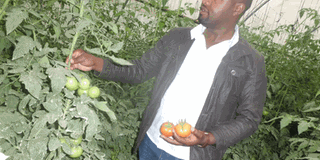What you must do to get quality tomato harvest

Julius Ahagaana in his tomatoe garden. The agronomist plants the vegetables in a greenhouse at Kabanyolo. Photo by Lominda Afedraru.
The goal for any farmer, small or large, should be to get the most food out of their available space. One great way is intercropping.
Catherine Atai, a seed multiplier at Kakusi-Igola in Serere District, started looking into alternative cropping systems in 2016. Today, her two-acre land is intercropped with ground nuts, sorghum, chia seeds and simsim (sesame).
Positives
Ugandan farmers engaged in growing tomatoes, keeping poultry and processing biological manure as well as animal and poultry feed are set to gain from the expertise of agricultural scientists from the Republic of Korea
A section of farmers in the districts of Wakiso, Masaka, Mityana and those around Makerere University Agricultural Research Institute, Kabanyolo (MUARIK) where the farm facilities are set have so far been trained in various technologies in the different area of farming. Other farmers trained include those in Masindi in post-harvest handling of maize and those in Kayunga in fruit drying processing especially pineapple fruit. This initiative is under a three-year project worth $1.83m and is run by the Korea International Cooperation Agency (Koica) through Chonbuk National University in collaboration with Makerere University College of Agricultural and Environmental Sciences (CAES).
The director of the project, Prof Jin Kook Cho, while explaining about the project initiative noted that KOICA is interested in empowering farmers in Uganda with new advanced farming technologies.
This he said will improve their livelihoods because they will be able to produce high quality tomatoes, eggs, animal and poultry feed which will fetch higher price in the open market.
Nutriculture in tomato growing
Explaining best practices of tomato growing using nutriculture, Cho pointed out that it involves growing tomatoes in a greenhouse with hydroponic culture. Hydroponic culture is a solution made out of natural biological nutrients called microbial consisting calcium and magnesium.
The construction of a greenhouse structure measuring 60m by 15m is underway at the Institute.
About 42 farmers have been trained in best practice of growing tomatoes and processing seedlings and 41 farmers trained in poultry keeping.
Best practices
In the statistics provided by Food and Agriculture Organisation (FAO) 2014 it is indicated that Uganda produces 35,579 tonnes of tomatoes annually and three million households consume tomatoes in every meal.
Farmers harvest 1.5 to 14 tonnes per hectare as compared to the average of 20 tonnes per hectare. Ronald Nsobya a farmer in Wakiso District, is one of the beneficiaries trained in tomato growing using improved technologies and he shares the knowledge acquired with Seeds of Gold.
Nursery management
Nsobya explains that before planting tomatoes a farmer is expected to produce seedlings in a nursery bed and the nursery trays are recommended.
It is important to prepare a raised seed bed or plant in clean trays. Soil mixture is prepared which is potted in seed trays for the seeds to grow. Seeds are planted one per cell of the tray and planting for seed beds must be done in straight row. It is important to maintain good moisture in the beds by watering at an appropriate time.
The beds or trays must be protected from direct sunlight by providing a shed or be done in a greenhouse.
Recommended varieties
The recommended varieties which are resistant to pests and diseases are Assila, VL 642, Ranger F1, Rounder F1, Valencia and Novel among others.
In case the farmer is growing it in a greenhouse, the field preparation is the same as in the open field and these include ploughing and thereafter mixing the soil with manure which can be cow dung and chicken dropping.
The farmer is expected to make ridges for water to flow and for better field management.
Transplanting
When the seedlings are six to nine inches tall they are ready for planting and this is after six to eight weeks of growth. Once transplanted, ensure the spacing is 35cm by 100cm and spraying can be done from one to two weeks of growing. But for planting in greenhouses, this may not be necessary. Ensure greenhouse temperature is 24 to 27 degrees Celsius. It is important to mulch the field to keep the soil moist.
Crop management
Ensure good soil moisture all the time and check on the field once or twice a day to monitor any pest and disease infection. Nutrient management at different stages is key. In this case application of microbial mixture is important.
A farmer who may not afford hydroponic technology can directly drip the solution to the plant root at an appropriate interval.
Pruning and staking
Farmers are expected to tie the plants loosely to stakes with twine to keep them upright as they grow. Use plastic garden clips where necessary to secure the twine.
In peak growing season, the plant will grow up to 15cm per week and will need tying each week.
It is important for a farmer to remove all side branches as they grow. This will enable the tomato to develop well.
Pests and diseases
The common tomato pests include Cutworms which feed on the seedlings, Hornworms capable of decimating mature tomato plants, Potato Beetle, Stink Bugs and Mites. These can be sprayed with appropriate pesticides. But once microbial is used at start, this challenge can be avoided.
The diseases are fusarium wilt, early and late blight, and leaf spot which are caused by fungi that prefer damp, cool conditions.
Experts advise farmers to apply irrigation in the morning to avoid conditions that encourage fungal growth or mould.
Harvesting and storage
Farmers are advised to leave the tomatoes on the vine as long as possible.
The perfect tomato for picking will be firm and red in colour, regardless of size, with perhaps some yellow remaining around the stem.
Once picked it is important to keep in boxes of a tray and in a cool place to avoid rooting.




